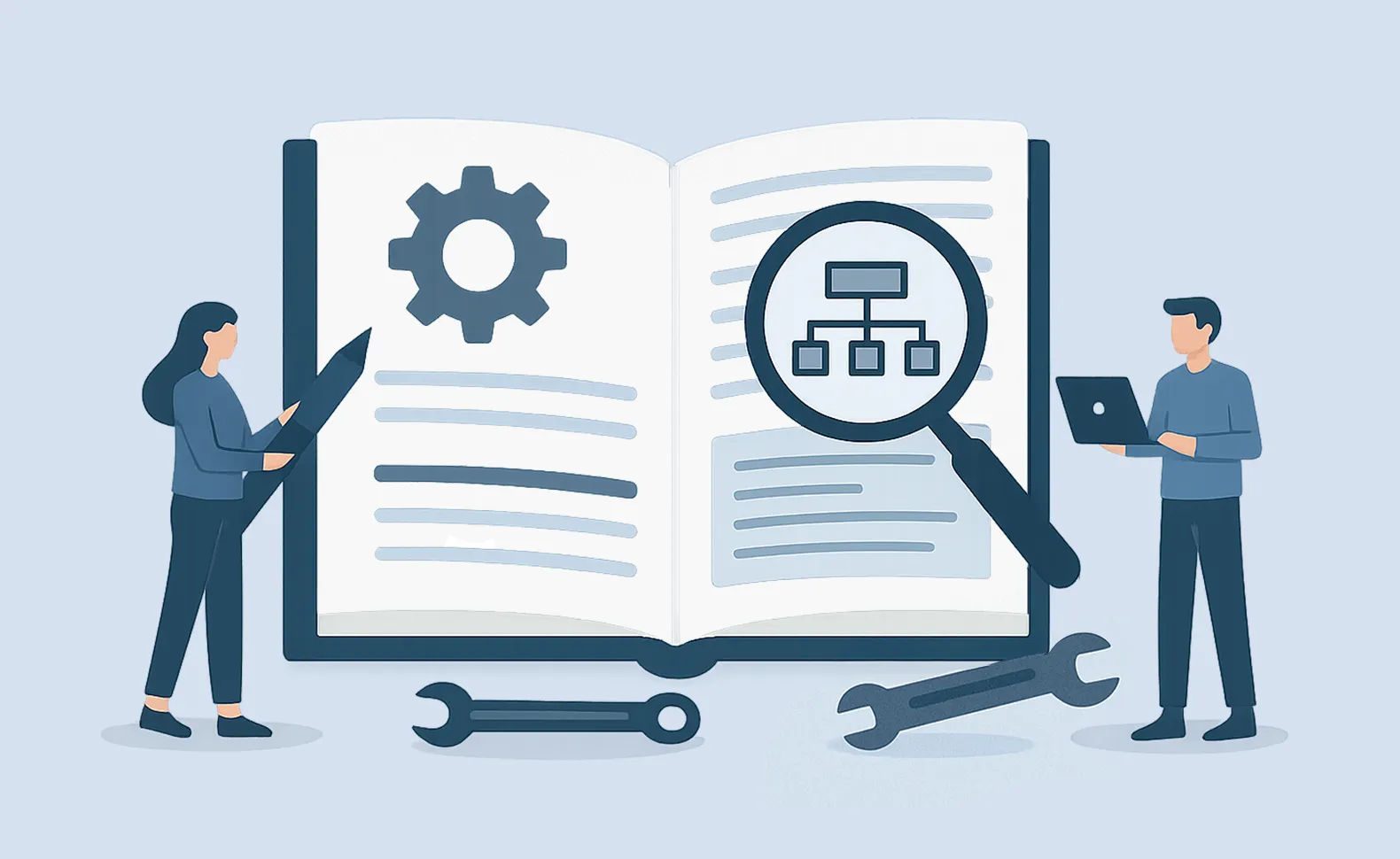The most important thing in brief:

What is technical documentation?
Technical documentation is a structured collection of information that comprehensively describes a technical system, product, or solution. The aim is to provide various target groups such as developers, administrators, users, auditors or support teams with a complete understanding of the structure, function, installation, operation, maintenance and development of the system. It serves as the basis for efficient operation, smooth maintenance and the safe development of technical systems.
Components of technical documentation
- System overview: Description of purpose, components, architecture, and functionality.
- Technical specifications: Information on hardware, software, interfaces and protocols used.
- Installation instructions: Step-by-step installation and initial configuration instructions.
- Operating and maintenance instructions: Information about routine tasks such as backup, monitoring, and troubleshooting.
- Safety aspects: Access protection, encryption mechanisms, emergency plans.
- Version history: Documentation of changes, updates, and changelogs.
- Developer documentation: API descriptions, code samples, and development guidelines.
This content is often supplemented by visualizations such as network plans, flow charts or entity relationship models to better represent complex relationships. Good technical documentation is clearly structured, up-to-date, understandable and prepared for the target group.
What types of technical documentation are there?
- system documentation
- user documentation
- Installation and configuration documentation
- Maintenance and operation documentation
- developer documentation
- safety documentation
- Process and operational documentation
- IT documentation
- Project and development documentation
- Product specifications
- Test and quality assurance documentation
Practical relevance: Technical documentation in everyday IT life
In practice, the value of well-founded technical documentation is particularly evident in stressful situations: If, for example, a business-critical server fails, well-documented emergency plans are worth their weight in gold. IT administrators can quickly understand which systems are affected, which dependencies exist and how the recovery should take place. New team members also benefit, who can familiarise themselves more quickly when configurations, processes and structures are comprehensibly documented.
Audits or certifications (e.g. ISO 27001) also require comprehensive technical documentation to prove compliance with safety standards and regulatory requirements. Central, always up-to-date documentation saves time and resources here.
Die IT documentation is a special form of technical documentation. It focuses on IT systems, infrastructures and processes. While technical documentation can generally also relate to mechanical or electrical engineering, IT documentation deals specifically with the digital infrastructure. It is essential for ensuring IT security, availability, and compliance.
Typical content of IT documentation:
- Network plans and topologies
- Server, client, and application overviews
- Firewall, router, and switch configurations
- User administration and assignment of rights
- Backup and recovery strategies
- System manuals for administrators and users
- Operational and change management processes (e.g. ITIL)
- IT security concepts (e.g. in accordance with ISO 27001 or BSI IT basic protection)
- License management and software inventory
Why is technical documentation necessary?
1. Operational safety and troubleshooting
Well-founded technical documentation enables administrators to react quickly to faults and initiate targeted measures. Without this documentation, dependencies and configurations can often only be understood through lengthy research.
2nd Securing knowledge
Documented knowledge is a decisive success factor, especially in times of high fluctuation. If long-time IT employees leave the company, valuable information is often lost without documentation.
3rd Compliance and legal requirements
Numerous regulations — such as the GDPR, ISO/IEC 27001 or the Basic IT protection of the BSI — require comprehensible documentation of the IT systems and processes used. A lack of proof can lead to significant legal consequences in an audit or in the event of a data breach.
The BSI provides further information on regulatory requirements on basic IT protection.
The challenges of creating technical documentation
Many IT departments are struggling with the same issues:
- Manual effort when collecting data
- Lack of timeliness through rare updates
- data inconsistencies through parallel maintenance in various tools
- Confusing document storage
These challenges often result in documentation being either incomplete or simply out of date — making it useless in an emergency.
Docusnap: Software-supported IT documentation made easy
Our software is a powerful tool for creating and maintaining technical documentation in the IT environment Docusnap. It helps IT teams to keep the documentation of their entire IT infrastructure automated, structured and up to date. In doing Docusnap collects information without agents about network devices, servers, clients, user rights, software installations, cloud components and much more.
Practical example: Instead of network plans When drawing manually, Docusnap automatically generates them and displays them graphically. Changes in the network are also identified and documented during regular scans. This not only saves enormous time, but also reduces sources of error and creates a high level of transparency across the IT landscape.
Docusnap also provides features for:
- license management
- Permission analysis
- ITIL-compliant process support
- Report- and plan generation at the push of a button
For IT managers, administrators and security officers, Docusnap is therefore a central tool to meet increasing requirements for traceability, security and efficiency.
Technical documentation — a conclusion:
Technical documentation is the generic term for structured technical information. IT documentation is a specific use case within this category. Anyone who creates IT documentation therefore works within the framework of technical documentation and makes a decisive contribution to transparency, security and efficiency in IT operations. The use of modern tools such as Docusnap makes this task much easier and creates the basis for sustainable IT organizations.
Next steps
Start your IT documentation with an automated inventory — Docusnap provides you with the appropriate functions. Use the integrated visualization, compliance, and maintenance modules to keep your documentation structured and up to date. Test now free of charge for 30 days and lay the foundation for future-proof IT.
Try it now for free


